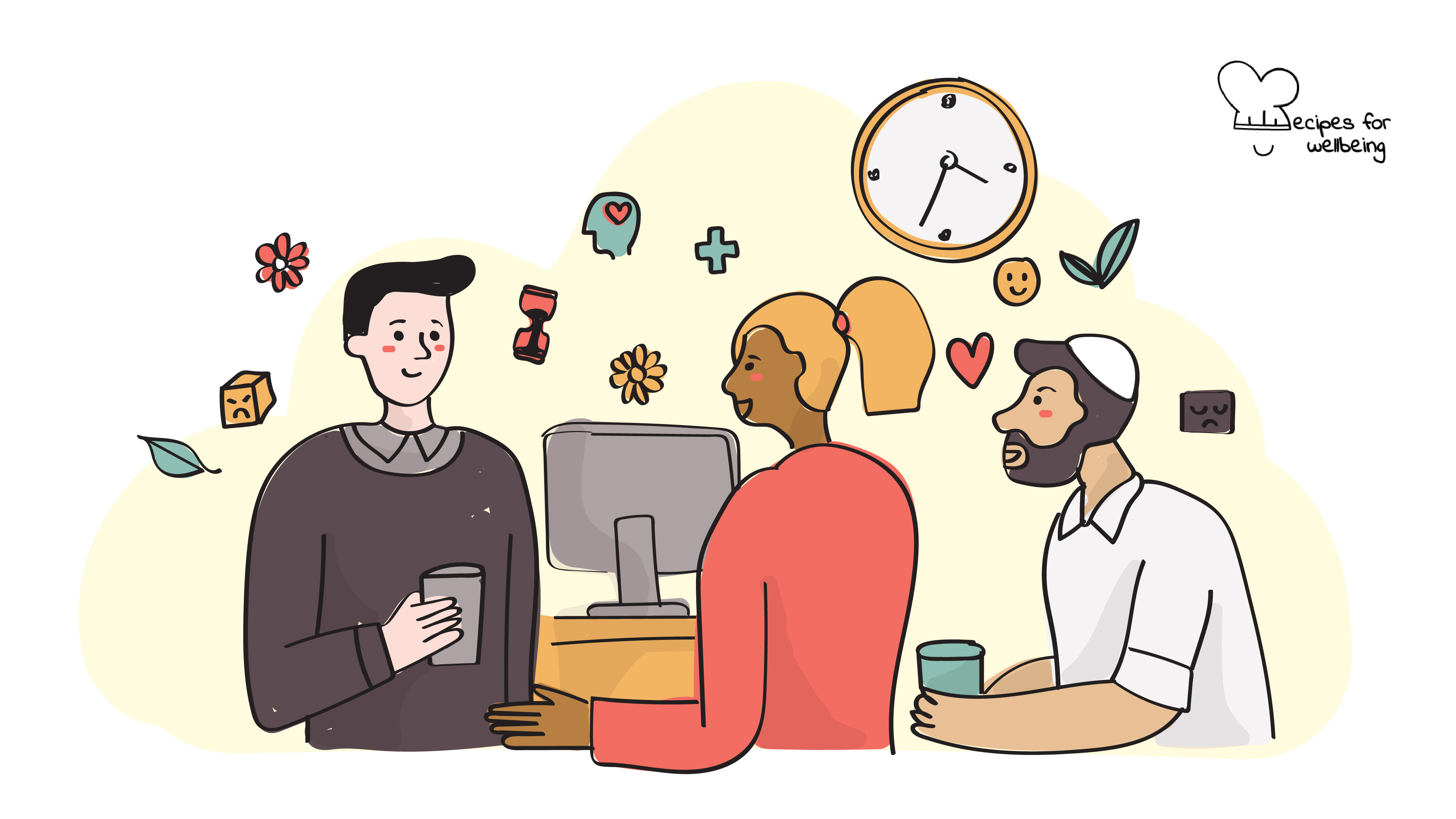
Talking mental health in the workplace
The humanity we all share is more important than the mental illnesses we cannot. —Elyn Saks
👥 Serves: 11-25 people, 2-10 people, 26-40 people, 41+ people
🎚 Difficulty: Hard
⏳ Total time: Ongoing
🥣 Ingredients: Bravery, patience, and non-judgement
🤓 Wholebeing Domains: Discomfortability, Positive Emotion, Radical Care
💪 Wholebeing Skills: Acknowledgement, Calm, Caring, Happiness, Peacefulness, Relief, Self-regulation

Talking mental health in the workplace
📝 Description
Skills to discuss mental health concerns with work colleagues.
Mental health concerns every single person. Approximately 1 in 5 people live with a mental health condition and around 20% of the worlds children’s and adolescents are diagnosed with a mental health condition. So, if a mental health condition is not impacting you specifically, it is likely impacting someone that you know and care about. There are many different mental health conditions, each with its unique set of features. Depression and anxiety are amongst the most common, with an estimated 264 million people living with depression.
Despite the strides in discussing mental health on various large scale platforms, governmental programmes that support the cause, and even charities and organisations such as the World Health Organization raising the profile, people who live with mental health conditions still suffer with, on the larger scale, stigma, discrimination and human rights violations.
The ongoing COVID-19 pandemic has caused a noticeable increase in stress, fear of the unknown, anxiety, and isolation, leading to a lower quality of mental health globally. Now more than ever we must advocate for our own mental health in the workplace and learn how to navigate through challenging conversations with our colleagues to best support them.
This recipe has been inspired by the Canadian Centre for Occupational Health and Safety by our wellbeing content writer collaborator Marissa Del Mistro. This recipe is a useful supplement to our recipes “Mental health in the workplace” and “Mental health for employers”. We also invite you to check out our recipe “Words matter” to be more mindful about the words you use when talking about mental health and mental ill-health.
👣 Steps
Step 1 – Discussing mental health with the wider organisation
For an organisation to champion mental health, it’s important that your wider team feel safe bringing up the topic and to discuss their experiences. This can be done in several ways but should be tangible and available in policies. For example, there could be a mental health leave policy that encourages team members to take paid time off when they’re experiencing mental ill-health, policies about confidentiality around mental health, free or reduced cost for personal 1:1 therapy, monthly peer support groups led by a therapist, training for skill development and growth, balanced work demands based on workers’ capabilities and resources, clearly defined job descriptions, and even discounted health incentives such as gym discounts, weekly free yoga on-site, and healthy food programmes.
There should always be an open and honest environment, demonstrated by the leadership team that does not allow for stigma and discrimination and which welcome questions and feedback. Check out our recipes “Mental health in the workplace” and “Mental health for employers” for additional guidance.
Step 2 – Having a conversation with a colleague you’re concerned about (as long as needed)
If you notice a dramatic shift in a team member’s demeanour and attitude coupled with a decrease in performance, it is the responsibility of the organisation to inquire and act.
When booking in time for this conversation, be mindful that the person might be experiencing anxiety and may be afraid they are about to get into trouble. So, be gentle with the invitation and don’t leave them hanging by giving a vague description of the meeting. Perhaps you can schedule it in when you have a regular 1:1 catch up or schedule for a catch up at a café outside the office space.
When having the conversation, do not start with their performance or completion of work. That is not the goal of the conversation. Instead, lead with something observational such as, “I have noticed lately…”, “I have been concerned about your…”, “Do you feel comfortable talking about…?”, or “I’ve noticed you haven’t been yourself lately…”. Strive to be patient, gentle and empathetic.
There are social, body and verbal cues you should try and invoke as best as possible. These include:
- Actively listen by nodding, smiling, and keeping eye contact. Keep your posture relaxed with your hands unclenched and insight. Sit down and be eye level – never stand above them.
- Focus all of your attention on the person and eliminate distractions.
- Do not interrupt them when they are speaking.
- Provide enough personal space – this will vary depending on your specific culture and the nature of your relationship but between 2-4 feet or 0.6 should be a good starting place.
- Reassure them that you are a trusted and reliable confidant.
- Watch your tone and try to speak softly and with confidence.
- Avoid offering unsolicited advice.
- Use uncomplicated words and avoid challenging words or jargon that may be confusing.
- Check yourself and ensure you are coming from a place of no judgement by keeping an open mind and watching your tone and delivery.
- Repeat back to what they have shared to confirm you understand.
- Remain calm if they become very expressive or angry.
You may not have a successful breakthrough the first time you engage with your colleague. This could be for several reasons, so be patient and encourage them to speak to someone else they trust and remind me of the policies in places such as therapy, peer support and fitness. Encourage them to approach you if they feel up to it and wish to talk.

